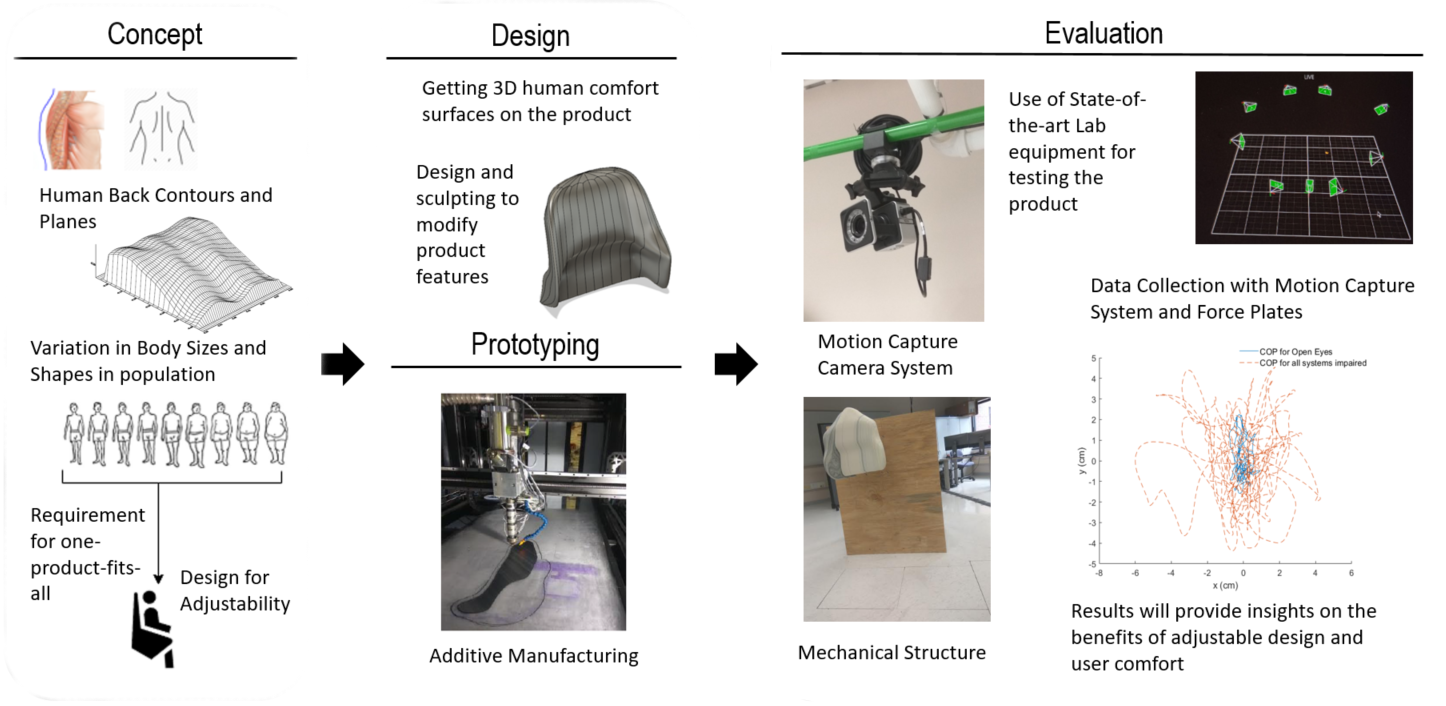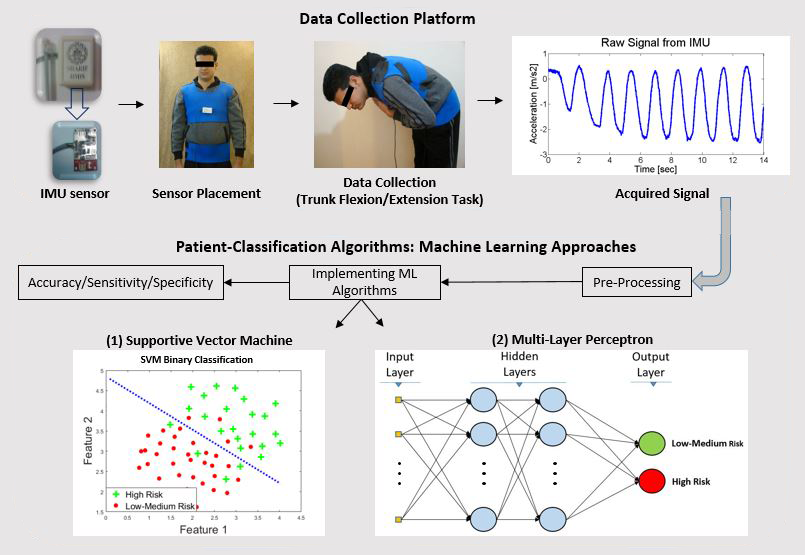Research
- RIT/
- Biomechanics & Ergonomics Lab/
- Research
Human Locomotion and Risk of Fall
Human Locomotion and Risk of Fall
Falls continue to be significant occupational safety issues and important causes of occupational injuries and fatalities. Various perturbations to human gait such as load carriage, muscle fatigue, and unexpected slips and trips can result in loss of balance and a subsequent fall. This area of research focuses on reducing the risk of fall by assessing the impact of these perturbations to the human gait, with the long-term goal of introducing proper interventions to mitigate the negative effects.
Effects of Unexpected Slips and Trips on Lumbar Kinematics, Lumbar Muscle Activity and Low-Back Loads

Slips, trips, and falls continue to be substantial safety issues. The current exploratory study quantified lumbar kinematics and kinetics during both induced slips and trips versus normal walking. Individual anthropometry, lumbar muscle geometry, and lumbar kinematics, along with electromyography of 14 lumbar muscles were used as the input to a 3D, dynamic, EMG-based model of the lumbar spine. Results indicated that, in comparison with values during normal walking, lumbar kinematics, lumbosacral kinetics, lumbar muscle activations, and lumbosacral reaction forces were all substantially increased during a slip and trip event. Observed levels of muscle activity and lumbosacral reaction forces suggest the potential for a low back injury during a slip event.
Our long-term goal is to utilize the outcome of this study to a biomechanical tool in order to reduce the risk and enhance the interventions (e.g., an occupational training system) related to slip- or trip-induced low back injuries. In particular, our developed model will facilitate determining the intervention parameters (e.g., training frequency, duration, intensity, etc.) to optimize intervention effectiveness. Accordingly, guidelines for more efficient task-specific gait training will be developed. This may lead to the control of specific mechanisms involved with low back disorders consequent to a slip or trip, and potentially reduce the risk of fall.
Effects of Load Carriage and Surface inclination on linear and non-linear Postural Variability

Understanding of inclined-work-related risk of falls and developing novel practical engineering controls for reducing this risk of falls among hilly working population remains in high demand. Standing on sloped surfaces provides a unique environment for examining the biomechanics and neural control of standing. The present investigation examined the variability of postural signals when standing on inclined surfaces and with load carriages by linear and nonlinear analysis. The purpose of this study was to determine if the sloped surface deteriorated in postural stability among healthy individuals with two distinct kinds of load carriage methods head versus posterior load carriage. Our results indicated that head load carriage when standing on uphill increased balance deterioration in healthy young subjects. We also found the significantly lower complexity of postural signals for head load carriage as measured by entropy. Understanding these underlying mechanisms of postural control with load carriage strategies in humans could productively help in developing preventive strategies to reduce the incidence of falls from inclined slopes.
Design and Development of Interventions
Design and Development of Interventions
Design and Development of an Adaptive Industrial Exoskeleton using the Smart Materials

Implementation of industrial assistive devices is one of the solutions to minimizing the high number of work-related musculoskeletal disorders in the working class. Among the devices, are the exoskeletons which enhance the strength and endurance of the user. We are working towards building a new type of assistive device which will be using flexible soft materials that can transform into a rigid structure. Current exoskeletons in the market offer limitations in terms of freedom of movement, bulky structure, and heavy weight, which may also cause detrimental effects on the human body. However, these industrial exoskeletons can be engineered to better suit the user by considering the ergonomics of these devices. Smart materials can provide an ability to tune material properties with the help of energy transfer. Applying these materials in exoskeleton design could provide the features of a soft flexible clothing while also being adaptable to a rigid supportive structure-based upon the demand on the body of the wearer. This can be achieved by building an adaptive control mechanism using real-time data relating to the state of wearer’s body. With the improved user-centric design of an exoskeleton, the acceptability of these devices will increase, also improving the safety and the productivity of the industrial workforce.
Design, Development, and Efficiency Assessment of a Hybrid Forklift Seat

Product Ergonomics considers the relation between the form and functionality of the human-product interface design in order to improve comfort, safety, and efficiency while operating the product. A variation in anthropometrics exists within the human population which may induce variation in perceived comfort by the user of the product. The goal is to develop products that can be a better fit with the entire range of population with varying physical characteristics and dimensions. Our work applies the human factors principles to a forklift seat, where the comfort of the user could be of critical importance. Using the concept of adjustability, a novel design is being developed that can adapt to a variety of comfort surfaces for the human back. We use additive manufacturing for rapid prototyping the designs, which can help in testing the validity and quantify the benefits of such a design. Further, we perform design evaluations using lab equipment like the state-of-the-art motion capture systems and force plates to compare the features of different designs. Such a study will provide insights upon the potential benefits of ‘Design for Adjustability’ in products and the effect of applying such a concept in forklift seating.
Performance Assessment Using Wearable Motion Capture Systems
Performance Assessment Using Wearable Motion Capture Systems
Development of a new fall risk assessment model for stroke survivors using motion sensors/smartphone data

Stroke is among the leading causes of death and disability. Among the stroke survivors, falls are more critical compared to healthy individuals since falls are seven times more prevalent. However, there is not an objective fall risk assessment method to implement independently with no need to show up in clinics or help of a care provider. This unmet need is the main objective of this study.
In this project, we are interested in developing a model to identify fall risk level for the individuals with stroke based on physical performance, during activities of daily living (ADLs), and clinical information. This project includes two phases: (1) fall risk scale development based on inertial measurement units (IMUs) signals which come from a set of XSENS sensors worn by the participants; (2) embed the developed model into a smartphone application along with replacing the sensor set with a smartphone.
The outcome of this study can facilitate the objective outpatient fall-risk assessment for stroke patients, thus enhance the physicians’ decision-making process on if their patients need to be referred to a PT to prevent potential severe falls. In fact, monitoring our new fall risk scale in the long-term can provide a prognostic tool for physicians in terms of the patients’ quality of gait, stability, and risk of fall.
Using an IMU sensor to categorize non-specific low back pain patients: a machine learning approach

Non-specific low back pain (NSLBP) remains a critical issue in primary care. Currently, clinical practitioners rely on subjective measures such as STarT Back Screening Tool (SBST) questionnaire to categorize NSLBP patients to pursue specific treatment regimens. However, the classification based on the questionnaire is highly prone to include error due to the subjective information collected from the patients.
In this project, our main objective is to develop a machine-learning-based model in order to classify the NSLBP patients, based on their trunk kinematics (from an IMU sensor on the chest), into different risk groups in accordance to STarT questionnaire. To this end, the patients will be asked to perform trunk flexion/extension task while the IMU sensor on trunk collecting kinematic data. Exploiting machine learning algorithms, the IMU signals will be analyzed to not only find the discriminating model with the highest accuracy but also identify the best feature set for discrimination.
The outcomes of this study may contribute to solving the long-lasting problem of objectively diagnosing NSLBP and its level in primary care, also help the clinicians and care providers to make more accurate decisions about the risk levels of the patients.
Theoretical & Practical Aspects of Human Muscle Fatigue
Theoretical & Practical Aspects of Human Muscle Fatigue

This ongoing research project is about the theoretical and practical aspects related to localized muscle fatigue (LMF). LMF has received increasing attention in many disciplines, and has been recognized as an important measure in research and interventions aimed at reducing musculoskeletal disorder risks in general, and WMSD risk in the occupational environment in particular.
Investigating the Exertion Variability of Index Finger Abduction on the FDI Muscle Fatigue
Many tasks in the workplace involve prolonged and/or repetitive muscle contractions, which can result in localized muscle fatigue (LMF), leading to reduced workers’ performance and increased the chance of WMSDs. Exertion variation has demonstrated mixed outcome on LMF reduction, potentially because of using different experimental protocols and complex biomechanical systems. In this study, our main goal was to observe how exertion variability during different working conditions affects the fatigue and recovery in FDI muscle.
Assessing the Influence of Variable Cognitive Load on Fatigue Development and Recovery of the First Dorsal Interosseous Muscle
With increasing costs of workers’ compensation, former studies have tried to analyze the influence of cognitive tasks on LMF development and recovery. The purpose of this study was to assess the influence of cognitive tasks of varying difficulty at a single level of exertion. Interestingly, some conditions with added mental demands showed reduced LMF compared to passive rest.
Investigating the effect of the blood flow on the muscle recovery
Our earlier studies showed the deficiency in predicting muscle fatigue and recovery; in particular the muscle recovery from a fatiguing state. In this project, we are assessing the influence of the blood flow on the muscle recovery using the diffuse optics techniques based on near-infrared light illumination. Outcomes of this research can contribute to the future design/evaluation of work tasks, particularly in a proactive fashion.